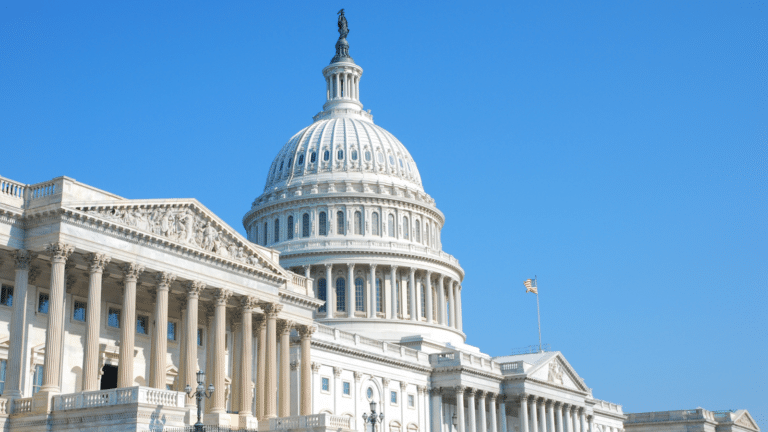This event summary reflects the authors’ understanding of key points made in the course of the discussion. It does not necessarily represent the views of the Center on Global Energy Policy. The summary may be subject to further revision.
Contributions to SIPA for the benefit of CGEP are general use gifts, which gives the Center discretion in how it allocates these funds. More information is available on our Partners page. Rare cases of sponsored projects are clearly indicated.
The Center on Global Energy Policy at Columbia SIPA organized a Battery Supply Chain Finance Summit on April 15, 2024, in collaboration with the Battery Materials and Technology Coalition, the Center for Strategic and International Studies, and the Energy Futures Initiative. The summit, hosted by S&P Global and supported by the US Department of Energy, included participants from the North American critical minerals and battery supply chain as well as strategic investors. It was held under the Chatham House rule.
Batteries and critical minerals are key building blocks of the energy transition, the digital economy, and national security. Over a period of three decades, the US and the West in general have allowed mineral refining capacity to offshore to China, which built up its comparative advantage, developing a globally competitive battery sector. China’s current approach in the battery materials market is characterized by maintaining production capacities that significantly exceed domestic needs. This strategy affords China the ability to dramatically influence global pricing and undercut competitors.
The battery supply chain finance summit evaluated where the North American industry is in terms of attracting financing and global competitiveness. It assessed global factors and US industrial policy. This summary highlights six key takeaways from the gathering.
1. Securing financing and offtake agreements: No chickens, nor eggs
The two most used words during the summit were not battery and mineral, but rather chicken and egg. Supply chain participants emphasized that development of the North American battery materials sector faces a fundamental challenge often described as the chicken-and-egg problem. For emerging technologies and projects within the domestic supply chain, securing financing is contingent upon having solid offtake agreements in place. However, potential offtakers are reluctant to commit without seeing evidence of financial backing. This cyclical problem stymies especially the initiation of projects on mineral processing and battery component manufacturing, according to participants, with a second phase attracting capital much more easily. There was a consensus among attendees that innovative financing structures and much more government intervention—and money—will be necessary to break this cycle.
2. Chinese overcapacity, supply, pricing power, and competitiveness
By leveraging overcapacity, which exists specifically in the midstream segments, like cathodes and cells,[i] China can reduce global prices at will, undercutting existing competitors and deterring new market entrants. Summit participants unanimously recognized that both implicit and explicit support by the Chinese government for these practices intensifies the competitive landscape, necessitating strategic responses from other countries to ensure supply security.
Some participants thought that China’s dominance in the battery sector isn’t merely a result of governmental policy but also stems from a comprehensive multidecade industrial policy that led to technology development and aggressive acquisition of overseas critical minerals to secure supply chains.[ii] It was recognized that this holistic approach enables China to maintain substantial control over much of the battery supply chain, posing a significant challenge to US ambitions of achieving diversification.
Participants also discussed how Chinese companies have made significant investments in regions capable of delivering Inflation Reduction Act (IRA)-compliant materials, such as Australia, Chile, Mexico, and Morocco. These investments are typically in the form of equity stakes or long-term offtake agreements, which are unlikely to be terminated by companies in US trade partner countries.[iii]
3. Lack of private investor interest
Although public funding for the battery materials sector has been somewhat available, private sector investment remains significantly underrepresented, according to participants. The reluctance from private investors stems primarily from the sector’s high-risk profile, characterized by lengthy development cycles and the inherently volatile nature of commodity markets. To draw in more private capital, attendees noted a pressing need for improved risk mitigation strategies, such as government guarantees or strengthened public-private partnerships.
The most significant potential investors, notably battery producers and automakers, remain hesitant to engage in offtake contracts with new suppliers who still require financing and must undergo extensive qualification processes. These contracts are not only vital to the planning of midstream players, but also for the operational planning of original equipment manufacturers (OEMs). Because of this, the associated uncertainties with smaller, more expensive players make these agreements less appealing.
Automakers, in particular, have to prioritize the size and speed of offtake agreements, as these factors provide them with the most operational certainty and ability to scale up in a highly competitive market. They are currently unwilling to pay a premium for North American supplies, participants said, because those premiums could jeopardize their competitiveness in both global and domestic EV markets.
The investment climate is further dampened by a lack of stable regulatory frameworks, clear demand forecasts, and competitive cost structures. Without these components, attendees expected that the financial community will remain cautious, concerned about the sector’s capacity to yield predictable and substantial returns.
At the core of the financing challenge are the extended lead times required for project ramp-ups, especially for a company’s first processing and manufacturing plant, which include purchasing and installing equipment and lengthy material qualification processes by battery producers and automakers. These lead times delay revenue generation in a market susceptible to volatility and price manipulation, adding layers of uncertainty for investors.
Despite global robustness, some investors are concerned about the slowing growth rates in EV and battery demand, as observed in 2023, volatile mineral prices, high inflation, and tight margins.[iv] However, industry representatives at the summit highlighted that North American demand remains strong relative to the limited supply from domestic players, underscoring the necessity to protect this emerging sector. Yet, with open markets and competition from Chinese players, participants pointed to the fact that declining battery prices have led to significant margin compression among mineral processors. Participants also found that medium-term forecasts pointing to potential bottlenecks in mineral production and processing are not currently determining market trends as much as short-term drivers.
Additional structural hurdles exacerbating the industry’s difficulties include higher interest rates and what participants called broken permitting regimes, which they said urgently needs bipartisan political progress.
4. The US government is committed … or is it?
The Biden Administration has demonstrated a strong commitment to bolstering the US battery minerals and materials sector, which it has considered both a key element of future industrial policy and a crucial aspect of national security. This commitment is reflected in strict guidelines on Foreign Entities of Concern (FEOC), whereby companies with over 25% Chinese ownership cannot supply Inflation Reduction Act (IRA)-compliant materials for use in electric vehicles that benefit from substantial tax credits.[v] The Department of Energy was recognized by supply chain participants at the summit as an active and proactive partner, although the consensus is that current efforts, while significant, are largely insufficient to meet the challenge.
The US government has rolled out billions in loans and grants with additional support forthcoming.[vi] Despite these efforts, the unpredictability of the US political system poses a substantial challenge and undermines a long-term, strategic industrial policy that is needed to potentially match China. All participants agreed that the variability in administration policies, exemplified by past shifts in fuel economy standards, introduces a degree of political instability that complicates strategic planning for businesses and investors.
5. New policy levers to explore, with consideration of their opportunity costs
New policy proposals may offer potential benefits, but also come with their own set of challenges and considerations. The effectiveness of these policies will depend on careful implementation and the stated objective, with diversifying supply away from China and achieving energy transition goals increasingly at odds.
Tariffs
The day-long summit was held before the US administration raised tariffs on Chinese EVs to 100% and on batteries and critical minerals to 25%. Participants agreed that while protectionist measures such as tariffs aim to protect US manufacturers from international competition, particularly from China, their use could lead to unintended consequences. These might include escalating trade wars or increasing consumer costs. Supply chain participants also emphasized that higher tariffs might not adequately counteract the competitive advantages of Chinese products, which benefit from lower production costs and well-established supply chains. The potential for tariffs to maintain competitiveness in the midstream sector remains uncertain and could possibly exacerbate market tensions without resolving core competitiveness issues.
Hard Mandates
Some form of mandates for the share of electric vehicles in total sales was seen by participants as promising, but they may prove challenging within the US context, similar to previous experiences with fuel economy standards. However, mandates have been shown to work.[vii] For example, the European Critical Raw Materials Act to cover 25% of EU critical minerals demand from recycling by 2030 has significantly motivated the industry and investors.[viii] This approach, however, can only work when targets are enforceable and don’t change based on the administration in power.
Price Floors
Participants discussed the concept of government-supported price floors as potentially beneficial but requiring careful study to ensure efficiency and effectiveness. They noted that previous applications, such as contracts-for-difference in agriculture, have shown mixed results. Participants also said that physical stockpiling by the government might not be feasible, given regulatory, governance, and institutional constraints to make such a system work.
Public Procurement
Public procurement could be a powerful tool, as demonstrated by China’s success with state purchases of electric buses and policies aimed at fully integrated supply chains.[ix] The US could consider similar large-scale public procurement initiatives to stimulate domestic industries and secure supply chains.
Data Transparency
The government could play a significant role in enhancing data transparency, including the active collection, analysis, and publication of data related to demand forecasts, supply conditions, cost curves, and overall industry dynamics. Improved data transparency could inform better decision-making across the sector.
Market Bifurcation
Some summit participants suggested creating separate markets based on geographical origin (Chinese versus Western) or environmental, social, and governance (ESG) performance. While this could theoretically reduce the competitiveness of Chinese supplies, it is uncertain whether automakers and battery manufacturers would be willing to absorb the associated cost premiums, especially given current market pressures and competition. The argument that Chinese supplies would not be able to reach higher ESG standards to access bifurcated markets is also without evidence.
R&D Investment
Participants universally acknowledged the competitiveness of US research and development as a key strength. Industry stakeholders at the summit support the idea of leveraging superior technology to outcompete China, particularly in developing EV batteries with increased range, faster charging, and lower costs. However, attendees equally noted that China is similarly investing heavily in R&D for the same end goals, making it at best uncertain that US R&D will lower costs enough to compete one-on-one. For example, Chinese battery manufacturer CATL has an R&D staff as high as 18,000.[x] China’s technology development is also focused on technology exports,[xi] thus directly competing.
Workforce Development
Workforce development is a critical area where government intervention can make a significant difference. Unlike China, which does not face significant workforce constraints, participants believed the US needs robust policy support in this area to scale up industry activities and meet growing sector demands. They said a lot of the current US skilled labor for midstream projects are emigrants from China.
Other Financial Instruments
Several participants raised ideas for employing additional financial instruments, including exploring the use of municipal bonds and negotiating shorter qualification periods for North American battery materials. One idea that received attention was utilizing memoranda of understanding (MOUs) between offtakers and mineral processors or component manufacturers to demonstrate to investors OEM interest and commitment under certain conditions. This softer form of offtake could help provide clearer pathways for investment by defining specific conditions under which OEMs would commit to purchasing materials.
6. Greater attention to certain supply chain segments
Certain segments of the supply chain, notably those involving critical minerals like graphite and lithium, require targeted focus, participants said. Lithium because there is a large supply deficit on the horizon, according to several models.[xii] Graphite because China controls commanding shares in both the natural graphite and synthetic graphite markets.[xiii] Developing alternative sources and enhancing processing capabilities within North America and its allies is crucial to ensuring supply security and lowering the potential Chinese grip. But this will take time—something the US seems to acknowledge with its final FEOC rules.[xiv]
Conclusion
These key takeaways from the Battery Supply Chain Finance Summit highlight some of the multifaceted challenges facing the North American battery materials sector. Addressing these challenges will require coordinated efforts among various stakeholders, including federal, state, and local governments; private investors; and industry leaders. Because industry expansion will involve public and private capital, an evaluation of its opportunity costs is necessary.
The US faces a delicate balance between promoting domestic industries and keeping consumer costs low—and therefore the pace of the energy transition fast enough to contribute to meaningful climate change mitigation. Participant discussions made clear that any industrial policy will need to guarantee that actual progress is made on the competitiveness front to advance energy transition ambitions and avoid creating companies whose profits are basically government support rents.
While this summit focused on US industrial policy to support North American players, several participants said it is essential to highlight that the US and the West at large will also need to strengthen international partnerships through initiatives such as the Development Finance Corporation, critical minerals agreements with allied countries, and a more robust Minerals Security Partnership, which is a collection of allied countries that seeks to support the development of critical mineral supply chain projects across the world to help diversify supply. Most participants agreed that more onshoring in combination with friendshoring is especially necessary as Chinese firms are establishing operations in free-trade partner countries to the US, such as Mexico and Morocco. In Morocco, for example, in one of several large Chinese investments, the company Gotion announced a $6 billion, 100 GWh gigafactory.[xv] Participants argued that such moves could threaten the North American supply chain if they are structured to comply precisely with IRA requirements. While some may consider China reducing its ownership share in such joint ventures a success in reducing its overall influence from within its own borders, participants were in consensus that this nonetheless undermines the competitiveness of North American players.
Notes
[i] https://www.bloomberg.com/news/newsletters/2024-04-12/china-already-makes-as-many-batteries-as-the-entire-world-wants
[ii] https://www.brookings.edu/wp-content/uploads/2022/08/LTRC_ChinaSupplyChain.pdf
[iii] https://www.afr.com/companies/mining/china-buys-half-of-the-lithium-mines-on-the-market-20230825-p5dzhc
[iv] https://iea.blob.core.windows.net/assets/a9e3544b-0b12-4e15-b407-65f5c8ce1b5f/GlobalEVOutlook2024.pdf
[v] https://www.energy.gov/articles/doe-releases-final-interpretive-guidance-definition-foreign-entity-concern#:~:text=The%20BIL%20defines%20a%20FEOC,%2C%20Iran%2C%20and%20North%20Korea.
[vi] https://www.energy.gov/lpo/articles/sector-spotlight-critical-materials
[vii] https://www.iea.org/reports/global-ev-outlook-2021/policies-to-promote-electric-vehicle-deployment
[viii] https://www.consilium.europa.eu/en/press/press-releases/2024/03/18/strategic-autonomy-council-gives-its-final-approval-on-the-critical-raw-materials-act/
[ix] https://www.changing-transport.org/wp-content/uploads/2020_GIZ_New-Energy-Buses-in-China.pdf; https://academic.oup.com/cje/article/47/1/45/6843623
[x] https://www.ft.com/content/1f95d204-ea6a-4cf3-b66a-952362e8092a
[xi] https://www.reuters.com/technology/chinese-battery-giant-catl-looks-set-up-rd-centres-hong-kong-underpin-technology-2024-03-04/
[xii] https://www.iea.org/reports/global-critical-minerals-outlook-2024
[xiii] https://www.energypolicy.columbia.edu/chinas-latest-move-in-the-critical-mineral-and-technology-trade-war/
[xiv] https://source.benchmarkminerals.com/article/graphite-feoc-sourcing-extension-supports-us-battery-expansion-but-highlights-chinas-dominance
[xv] https://rhg.com/research/pole-position-chinese-ev-investments-boom-amid-growing-political-backlash/






